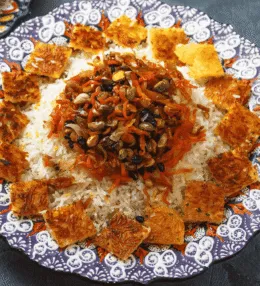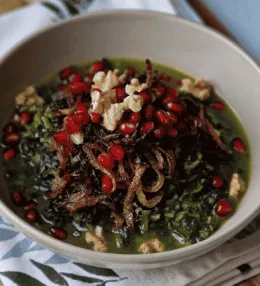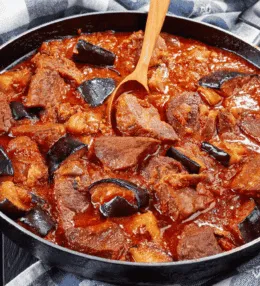
- View
Table of Contents
ToggleJuju Dhau, often called the ‘King of Curds’, is a creamy, sweetened yoghurt that hails from Bhaktapur, an ancient city in the Kathmandu Valley of Nepal. Renowned for its smooth texture and rich flavour, it holds a cherished place in Nepali culture, especially among the Newar community.
Served during festivals, rituals, and special occasions, Juju Dhau is more than just a dessert. It symbolises purity, prosperity, and celebration. Whether offered to deities or shared among loved ones, this curd reflects a deep respect for tradition and craftsmanship in Nepali cuisine.
Want to dive deeper into Nepalese Cuisine? Don’t miss our post on 15 Traditional Nepalese Foods to Try
What Is Juju Dhau?
Juju Dhau is a special type of yoghurt, traditionally made from buffalo milk and set in small clay pots. What sets it apart is its thick, velvety consistency and a natural sweetness that comes from simmering the milk and carefully fermenting it to perfection.
The clay pots are not just for show. They play a crucial role in drawing out moisture and giving the curd its dense texture. This yoghurt is often enjoyed chilled and eaten on its own, though it can also accompany other sweets or be part of ceremonial meals.
Ingredients and Taste
The heart of Juju Dhau lies in its simplicity. Rich buffalo milk is boiled slowly to intensify the flavour, then sweetened slightly and allowed to cool before a small portion of starter curd is added to kickstart fermentation.
Once poured into traditional clay pots, the milk mixture is left undisturbed in a warm space to set naturally. The end result is a luxuriously thick yoghurt with a faint caramel note, a glossy surface, and a firm yet creamy spoonful.
The taste is delicately sweet with a mild tang that’s characteristic of well fermented yoghurt. The use of buffalo milk adds a depth and richness not found in regular cow’s milk yoghurts. Its freshness and balance make it both indulgent and refreshing.
A Taste of History
The name ‘Juju Dhau’ comes from the Newar language, where ‘juju’ means king and ‘dhau‘ means curd. True to its name, it was once served exclusively to royalty and offered during sacred rituals as a symbol of blessing and abundance.
Its roots stretch deep into the heritage of Bhaktapur, a city known for preserving ancient customs. Local dairies have passed down the art of making Juju Dhau through generations, each family guarding their method with quiet pride.
The clay pots used to set the curd are hand crafted by local potters, making each serving a blend of culinary and artisanal tradition. These vessels not only aid the texture but also represent a deep link to the land and its people.
Juju Dhau’s fame has gradually moved beyond the valley, becoming a must-try for visitors who seek an authentic taste of Nepal. Despite modern alternatives, the most treasured versions still come from the backstreets of Bhaktapur, where age old methods and community spirit remain at the heart of every pot.
How to make Juju Dhau
Known as the “King of Curds,” Juju Dhau is a thick, silky yoghurt treasured in the historic city of Bhaktapur, Nepal. Traditionally set in clay pots, it boasts a rich texture and sweet floral aroma, crafted from buffalo milk for added creaminess. Making it at home captures the quiet elegance of slow fermentation and the earthy charm of handmade food. Patience is key, but the result is worth every minute. See the recipe card at the bottom for printable directions
Ingredients
- 1 litre full fat buffalo milk (or cow’s milk with 1 to 2 tablespoons cream for richness)
- 3 tablespoons plain unsweetened yoghurt (with live cultures, as starter)
- 4 tablespoons sugar (traditionally unrefined cane sugar if available)
- 1 teaspoon cardamom powder (optional, for subtle aroma)
- 1 clay or earthenware pot (for authentic texture and taste)
- Cotton cloth or foil (to cover)
Cooking Instructions
Step 1: Boil the Milk
Pour the milk into a heavy bottomed pot and bring it to a gentle boil over medium heat. Stir continuously to prevent scorching and reduce slightly for a richer base. Once it reaches a boil, lower the heat and simmer for 5 to 7 minutes.
Step 2: Sweeten and Infuse
Stir in the sugar and optional cardamom powder until fully dissolved. This adds sweetness and a delicate fragrance. Turn off the heat and allow the milk to cool until it reaches a lukewarm temperature, around 40 to 45°C (warm to the touch, not hot).
Step 3: Prepare the Clay Pot
Rinse the clay pot with hot water and allow it to dry naturally. The slight porosity of the pot allows some water to evaporate during fermentation, helping to thicken the curd.
Step 4: Add the Starter Culture
In a small bowl, mix the yoghurt starter with a spoonful of the warm milk to loosen it. Gently whisk this into the rest of the milk, ensuring even distribution without creating foam. Avoid vigorous stirring.
Step 5: Pour and Cover
Pour the milk mixture gently into the clay pot. Do not disturb it once poured. Cover loosely with a cotton cloth or foil to allow natural air contact while keeping dust out.
Step 6: Allow to Set
Place the pot in a warm, undisturbed area for 6 to 8 hours, or overnight. A consistent warm environment (around 30 to 35°C) is ideal. Avoid moving the pot during this time to prevent the curd from breaking.
Step 7: Refrigerate to Firm Up
Once set, transfer the pot to the refrigerator and chill for at least 2 hours. This not only firms the curd further but enhances the creamy texture and flavour.
Final Step: Serve the Juju Dhau
Scoop gently into small serving bowls, keeping the top layer intact for presentation. Serve plain or topped with a sprinkle of crushed pistachios or a few strands of saffron. Avoid mixing before serving to preserve the natural layers.
Cooking Tips for Perfect Juju Dhau
- Use buffalo milk for the richest texture. If unavailable, add cream to cow’s milk.
- Do not disturb the pot during fermentation; movement can prevent setting.
- Clay pots are essential for authenticity. They absorb moisture and help develop a thicker curd.
- Maintain a warm setting to encourage proper fermentation. In cooler months, wrap the pot in a towel or keep near a warm appliance.
- Avoid metal pots or spoons when setting the curd as they may interfere with fermentation.

Nepali Juju Dhau (Royal Curd)
Ingredients
- 1 litre full fat buffalo milk or cow's milk with 1 to 2 tablespoons cream for richness
- 3 tablespoons plain unsweetened yoghurt with live cultures, as starter
- 4 tablespoons sugar traditionally unrefined cane sugar if available
- 1 teaspoon cardamom powder optional, for subtle aroma
- 1 clay or earthenware pot for authentic texture and taste
- Cotton cloth or foil to cover
Instructions
- Pour the milk into a heavy bottomed pot and bring it to a gentle boil over medium heat. Stir continuously to prevent scorching and reduce slightly for a richer base. Once it reaches a boil, lower the heat and simmer for 5 to 7 minutes.
- Stir in the sugar and optional cardamom powder until fully dissolved. This adds sweetness and a delicate fragrance. Turn off the heat and allow the milk to cool until it reaches a lukewarm temperature, around 40 to 45°C (warm to the touch, not hot).
- Rinse the clay pot with hot water and allow it to dry naturally. The slight porosity of the pot allows some water to evaporate during fermentation, helping to thicken the curd.
- In a small bowl, mix the yoghurt starter with a spoonful of the warm milk to loosen it. Gently whisk this into the rest of the milk, ensuring even distribution without creating foam. Avoid vigorous stirring.
- Pour the milk mixture gently into the clay pot. Do not disturb it once poured. Cover loosely with a cotton cloth or foil to allow natural air contact while keeping dust out.
- Place the pot in a warm, undisturbed area for 6 to 8 hours, or overnight. A consistent warm environment (around 30 to 35°C) is ideal. Avoid moving the pot during this time to prevent the curd from breaking.
- Once set, transfer the pot to the refrigerator and chill for at least 2 hours. This not only firms the curd further but enhances the creamy texture and flavour.
- Scoop gently into small serving bowls, keeping the top layer intact for presentation. Serve plain or topped with a sprinkle of crushed pistachios or a few strands of saffron. Avoid mixing before serving to preserve the natural layers.
Nutrition
You May Also Like







Leave a Review